‘Uncategorized’ Category
» posted on Saturday, August 27th, 2022 by Linda Lou Burton
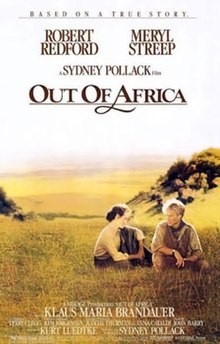 Linda Lou Burton posting from Little Rock, Arkansas – The second thing that has me longing to go Africa is due to a woman named Karen, who “had a farm in Africa.” It was Karen Blixen, pen name Isak Dinesen, who wrote “Out of Africa.” It was Meryl Streep’s lovely sing-song recitation of the first line of that book that stuck with me from the 1980’s, when she and Robert Redford made the movie of the same name.
Linda Lou Burton posting from Little Rock, Arkansas – The second thing that has me longing to go Africa is due to a woman named Karen, who “had a farm in Africa.” It was Karen Blixen, pen name Isak Dinesen, who wrote “Out of Africa.” It was Meryl Streep’s lovely sing-song recitation of the first line of that book that stuck with me from the 1980’s, when she and Robert Redford made the movie of the same name.
It was not until I actually read the book however, that I began to get a real sense of the magic of east Africa. Sydney Pollack turned Karen’s “love story” into a relationship with a good-looking English hunk. Yes, there were magnificent scenes of Kenyan scenery, and episodes of bravery, and tenderness, and the awful tragedy of losing both her lover and her farm. But that’s not the full story of the Karen Blixen to be found as penned by her own hand; though she was born in Denmark, Africa was the home of her heart. Her book, written in 1937 a few years after she was forced to leave, begins like this:
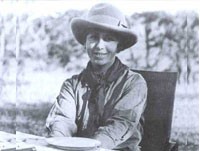 I had a farm in Africa, at the foot of the Ngong Hills. The Equator runs across these highlands, a hundred miles to the North, and the farm lay at an altitude of over six thousand feet. In the day-time you felt that you had got high up, near to the sun, but the early mornings and evenings were limpid and restful, and the nights were cold…The geographical position, and the height of the land combined to create a landscape that had not its like in all the world. There was no fat on it, and no luxuriance anywhere; it was Africa distilled up through six thousand feet, like the strong and refined essence of a continent. The views were immensely wide. Everything you saw made for greatness and freedom, and unequalled nobility…Up in this high air you breathed easily, drawing in a vital assurance and lightness of heart. In the highlands you woke up in the morning and thought: Here I am, where I ought to be.
I had a farm in Africa, at the foot of the Ngong Hills. The Equator runs across these highlands, a hundred miles to the North, and the farm lay at an altitude of over six thousand feet. In the day-time you felt that you had got high up, near to the sun, but the early mornings and evenings were limpid and restful, and the nights were cold…The geographical position, and the height of the land combined to create a landscape that had not its like in all the world. There was no fat on it, and no luxuriance anywhere; it was Africa distilled up through six thousand feet, like the strong and refined essence of a continent. The views were immensely wide. Everything you saw made for greatness and freedom, and unequalled nobility…Up in this high air you breathed easily, drawing in a vital assurance and lightness of heart. In the highlands you woke up in the morning and thought: Here I am, where I ought to be.
Dinesen, Isak. Out of Africa and Shadows on the Grass. New York: Vintage International, 1988, pp 3-4.
Why do I want to go to Africa? I want to see THAT place. I want to sit on Karen’s front porch, looking across that broad lawn where her people, the Kikuyu squatters and the Somali servants who helped to run the farm; who picked the coffee and cared for the house, but most of all, who were a central part of her daily life – gathered every day. Her connection with the people of Africa is the real story.
 When Karen lost her farm and returned to Denmark in 1931, her property was sold as large parcels for homes; the suburb that emerged is now called “Karen.” The original farmhouse changed hands several times, for a time housing a college; it was turned into a museum after the movie came out. Many of Karen’s original furnishings have been restored, and tours are offered continuously every day between 9:30 – 6.
When Karen lost her farm and returned to Denmark in 1931, her property was sold as large parcels for homes; the suburb that emerged is now called “Karen.” The original farmhouse changed hands several times, for a time housing a college; it was turned into a museum after the movie came out. Many of Karen’s original furnishings have been restored, and tours are offered continuously every day between 9:30 – 6.
I’ll be there soon.
Karen Blixen Museum, Nairobi, Kenya
https://www.museums.or.ke/karen-blixen/
» posted on Sunday, September 10th, 2017 by Linda Lou Burton
Capital Cities USA is an organization focusing on the 50 capital cities of the United States.
Why capital cities?
Capital cities are awesome! Think about it – they are the center of government for every state, so that’s a pretty big thing right there. And they didn’t come out of a cookie-cutter mold; each one of the 50 has a unique personality and its own great stories to tell.
Capital cities are every size and shape you can think of. Bustling Phoenix has over a million and a half residents; cozy Montpelier fewer than ten thousand. They have every climate you can imagine, with endless-daylight summer hours in Juneau and winter ice festivals in St Paul.
Some are way up high, like Denver, and Cheyenne, and Santa Fe, and some are nestled right beside the ocean, or a river, or a lake (check your map). Which capital city is the oldest? The youngest? Do you know?
Capital Cities USA covers it all. From what you’ll find when you visit, to what you’ll find if you are doing historical research. What is it like to live there? How did the city evolve and grow? How does the history of the city fit into the history of the United States?
What opportunities are available in each city for helping kids learn and grow, for helping teachers with good lesson plans? What is it like to be a family living there? Is there something fun Grandma and little Sam can share when he comes over for a Saturday afternoon?
Why do we need to know about our capital cities?
Despite all their differences, capital cities have one thing in common: each city represents the development of the state, and the 50 together outline the shaping of the United States, in all its vastness and diversity. Mainstays of American history, culture, traditions and democracy, the 50 capital cities and their capitol buildings are a continuum of past to present to future and as such are invaluable resources. They help us understand and learn from the past. They enable all of us to be informed and involved. They encourage responsible citizenship and inspire young people just beginning to learn the democratic process.
Remember – to make good old people you have to start them young!
» posted on Friday, September 8th, 2017 by Linda Lou Burton
A Bi-Polar Year: From the Arctic Circle to Antarctica will be released in 2018.
Here’s a peek at the intro.
It’s something I wanted to do for years. That is, to be north of the Arctic Circle on the first day of summer (June of course), and then to be south of the Antarctic Circle on the first day of summer in the southern hemisphere (December). This had to happen in the same year, I thought. And so it did.
The trip began in June, an easy ride from Seattle to Alaska and the northernmost point in North America. Point Barrow, polar bear country! Then life wound through summer, and autumn, and family, and friends, till I boarded a plane for my flight to Santiago, Chile, and my southbound ship that got me to Cape Horn on December 22. We crossed the Drake Passage in time for Christmas on the White Continent, where I met my first penguin.
Join me?
(c) Linda Lou Burton 2017
» posted on Friday, September 8th, 2017 by Linda Lou Burton
Bobby’s Absolutely Amazing Adventures in the Capital Cities to be released in 2018.
Bobby Wiring is ten years old. He’s a fifth-grader at Lewis & Clark Elementary. And, he lives in a capital city! Imagine the excitement at Lewis & Clark when teacher Mr Wilson announces the new Social Studies project — here’s a peek into Chapter One….
Bobby slurched his feet twice over the spongy black raincatcher mat at the school entrance and headed down the hall to Room 14. He turned in at the third flag-blue door on the right where the sign said:
Bobby dropped his backpack beside his desk and started to pull out books, homework, and his green-glow gel pen. Erasable. Mr Wilson was already at the board, intent on writing some mysterious announcement with a red marker. He wrote a few words and shielded them with his writing pad. Then he lowered the pull-down United States map a few more inches, to cover the words. The students in the front row were hunched forward, heads wobbling like bobble-head dolls as they tried to follow Mr Wilson’s big brown hand scribbling up and down, up and down, the markings hidden behind the pad. Even with eyes squinting, they could not decipher the secret message. Bobby could see a few letters at the right side of the board, a spot the map didn’t totally cover.
What did that mean? It was just like Mr Wilson to do something this way, to catch their attention from the first minute of class. He was the coolest teacher of Bobby’s life. He was big, he was strong, and he was smart. Before he was a teacher, he was a Marine, and he expected strict order in the classroom. Except, he was funny too. He could do the greatest accents you ever heard. When they studied another country in geography, Mr Wilson would slip into accent. Spanish, French, Russian, Italian, Chinese, and even the clicking noises of the little people in Africa’s Kalahari Desert. Mr Wilson had walked on all seven continents, a goal Bobby had set for himself. He knew he would do it, too. After all, he’d already been to both American continents. Two down, five to go!
Mr Wilson finished writing just as Mrs Green pushed Quang-Bao Mark’s wheelchair into his designated space in front of Bobby. She gave Bobby a knuckle-scrunch on the head and waved at the class before she scooted back out the door. Quang-Bao Mark Green was Bobby’s next-door neighbor and best buddy since before either of them could remember. He had never been able to walk, but he’d attended Lewis & Clark since Kindergarten. His wheelchairs got bigger as he grew, and the latest model had a nifty flip over desk top. All of his school supplies and books were in special side pouches. “The saddle bags on my horse,” he called them. His Uncle Levi had designed another attachment he wasn’t allowed to bring to school – Electronic Elmer – with music player, video games and even a GPS for global position satellite tracking. There was also a telescope mount for backyard stargazing. Quang-Bao Mark and Bobby were nuts about the stars.
Bobby pushed Quang-Bao Mark to Mr Chau’s grocery on Saturdays for treats – “Mr Chau’s for chow” they said. And Bobby pushed him to their baseball games, bats and gloves stashed in the Sports side pouch – the Dugout they called it — with drinks in the mini-cooler on the other side of the wheelchair. Quang-Bao Mark was the team statistician and record keeper; Bobby played first. “Stop trouble before it begins,” his Grandma Lucinda always said. He figured a good first-base player had a chance to do just that.
The 8:30 bell rang and everyone sat up straight, all eyes up front, waiting for Mr Wilson to speak.
“Bonjour class,” he began.
“FRENCH!” they called back to him. That was their morning game, to guess the language he spoke.
“Buenos dias!” he offered, and they quickly shouted “SPANISH!”
“Mangandáng umága!” Mr. Wilson came back. There was a moment of silence, then Lita DePano spoke up.
“That’s Tagalog Mr Wilson. That’s the first words I hear every morning when my Mom wants me to get out of bed!” Lita’s remark brought a laugh from the class and a smile from Mr Wilson.
“Correct Lita,” he said, slipping into an accent. “That’s a ‘Good Morning’ in Tagalog, a language of the Philippines. You are fortunate to have a mother teaching you to be fluent in two languages. Can you say ‘Please’ in Pilipino?”
“Pakisuyò is ‘Please,’” Lita answered.
“How about ‘I am sleepy’?” queried Mr Wilson.
“Inaantòk ako,” said Lita.
“And there you have it,” Mr Wilson grinned. “Pakisuyò, Inaantòk ako! Please, I am sleepy! Let me sleep another sampû minutes!”
“Yes!” Lita laughed, “ten more minutes of sleep!” Everybody was laughing now, in an unusually good mood for a rainy November Monday. Mr Wilson stepped back towards the board and attention once again focused on the secret message behind the map.
What was it?
“Class, we are beginning a new tradition here at Lewis & Clark,” Mr Wilson told them. He pointed to the big hand-lettered sign that always hung over his desk.
See The Possibilities!
“You are about to have an opportunity to see a LOT of possibilities,” he continued. “Your principal, Mrs. Nielsen, has asked all of the 4th and 5th teachers to announce the Greatest Social Studies Project ever. For the first time, Lewis & Clark will participate in the National competition. Here it is.”
He gave the map a tug, and it rolled up into its holder, revealing, at last, the message.
© Linda Lou Burton 2017. Your World – Know It! Show It! Grow It!™
» posted on Tuesday, September 5th, 2017 by Linda Lou Burton
I shall be telling this with a sigh somewhere ages and ages hence: Two roads diverged in a wood, and I— I took the one less traveled by, and that has made all the difference. Robert Frost, The Path Not Taken
Linda Lou Burton is a fearless explorer, always on the lookout for new adventures, new friends, and new stories. In her travels from the Arctic Circle to Antarctica, she photographed the Midnight Sun on the first day of summer at each end of the Earth – in the same year! She also crossed the Andes in a taxi, conversed eye-to-eye with penguins on their rocky turf, tracked polar bears (in a Hummer with a guide, of course), and had a quick breakfast at the northernmost McDonalds in the world.
In her two-year Journey Across America (2012-2013) with her traveling cats Alex the Crabby Tabby, and big black Jack, aka El Grande Lovebug, she lived in the capital cities in all 50 states, connecting with thousands as she gained an insider’s perspective on how people feel about “home,” wherever that might be.
Born in Jasper, Alabama and newly settled in Arkansas with blue-eyed Katy cat, Burton claims two more places as “home.”
“During twenty years of living alongside the Tennessee River in Chattanooga I raised three sons, earned a BS in Psychology from the University of Tennessee and taught there, owned a publications business, wrote a column for The Chattanooga Times, and authored Chattanooga Great Places and other travel guidebooks.
I lived in Seattle, with snow-capped Mt Rainier in view just to the south, for almost a quarter century, where I studied both Communications and History at the University of Washington and worked there, operated The Golden Apple B&B, and welcomed eleven amazing grandchildren into my life.
I came to Arkansas because my brother found a journal kept by our third great-grandfather William Irwin, who led a party on an ill-fated attempt to emigrate from Alabama to Texas in 1849. Their journey sadly ended here in wooded graves, but my new Arkansas home – a historic house smack dab between two universities — feels to me like a good place to dig more deeply into history, to reflect and spin the stories out.”
Burton now chairs Capital Cities USA, a nonprofit dedicated to humanities education, and invites students, teachers, researchers, and everyone interested in learning about the United States to visit the Capital Cities website.
www.capitalcitiesusa.org
Burton’s next travel adventure involves visiting world capitals– beginning with the northernmost capital in the world, Reykjavik, Iceland, and the southernmost, Wellington, New Zealand.
Her next writing project is a social studies book for children – Bobby’s Absolutely Amazing Adventures in the Capital Cities.
Patchwork Love is her first novel, available now at Amazon.com in both paperback and ebook format, to be followed by a fictionalized account of the Irwin journey that ended so tragically in Arkansas in 1849 with ten deaths, based on journals and letters kept through the ages. The focus will be on the survivors — two pregnant women, a four-year-old girl, and a slave named Penny.
Watch for all releases on the McNutt Street Books website and at Amazon.com.
www.amazon.com/author/lindalouburton.com
» posted on Wednesday, March 30th, 2016 by Linda Lou Burton
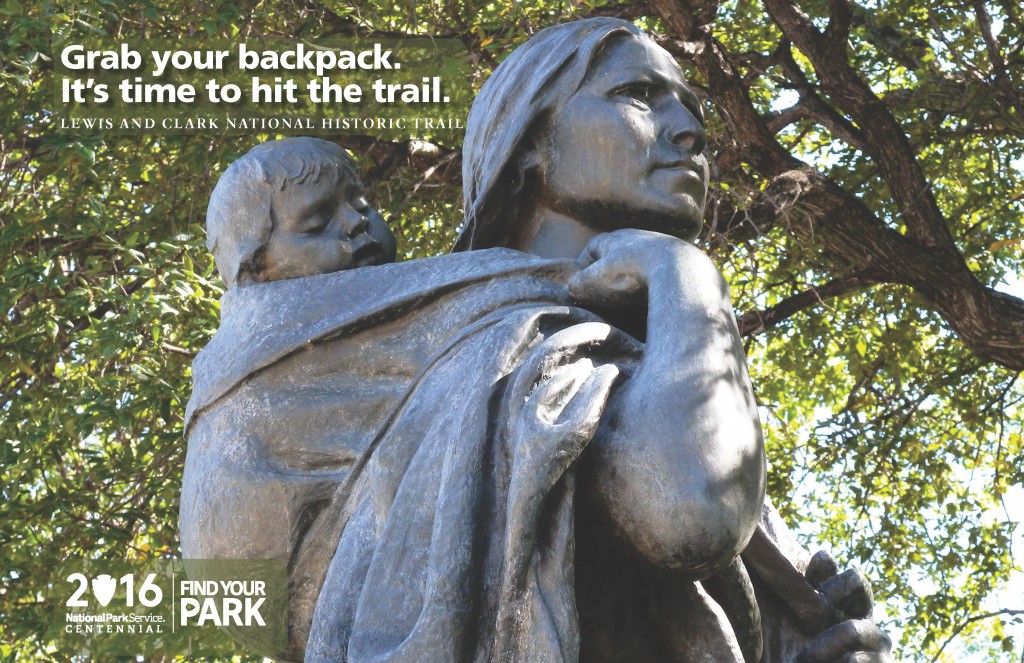 Linda Burton posting from Arkadelphia, Arkansas – Sacagawea was the original backpacker. She just slapped that little baby Pomp onto her back and struck out across the hills. The only female in the (likely) crude and smelly crew of Men on a Mission for the President, she trekked westward with skill and patience, all the while nursing a baby and nurturing them all. Reckon she ever thought she’d be famous? With a statue of herself and her baby in Statuary Hall in our national capitol? And that she and Pomp would be portrayed on a US Treasury gold dollar? (The only baby featured on a coin, by the way.) I love the story of this woman, who has more schools and creeks and monuments named to her honor than any other woman in the United States. That’s why I am particularly honored myself to have my picture of her statue featured on a US National Park poster. No fooling! Ryan Cooper, a geographer for the Lewis & Clark National Historic Trail, asked my permission to use a photo from my August 27, 2012 blog, He Called Her Janey, written while I was in Bismarck, North Dakota. “I want to use it on a poster celebrating the 100-year anniversary of the National Park Service in 2016,” he explained. I was pleased to grant him that permission. And I am pleased to share with you the poster he created. Isn’t it great?
Linda Burton posting from Arkadelphia, Arkansas – Sacagawea was the original backpacker. She just slapped that little baby Pomp onto her back and struck out across the hills. The only female in the (likely) crude and smelly crew of Men on a Mission for the President, she trekked westward with skill and patience, all the while nursing a baby and nurturing them all. Reckon she ever thought she’d be famous? With a statue of herself and her baby in Statuary Hall in our national capitol? And that she and Pomp would be portrayed on a US Treasury gold dollar? (The only baby featured on a coin, by the way.) I love the story of this woman, who has more schools and creeks and monuments named to her honor than any other woman in the United States. That’s why I am particularly honored myself to have my picture of her statue featured on a US National Park poster. No fooling! Ryan Cooper, a geographer for the Lewis & Clark National Historic Trail, asked my permission to use a photo from my August 27, 2012 blog, He Called Her Janey, written while I was in Bismarck, North Dakota. “I want to use it on a poster celebrating the 100-year anniversary of the National Park Service in 2016,” he explained. I was pleased to grant him that permission. And I am pleased to share with you the poster he created. Isn’t it great?
Ryan’s 2016 Lewis & Clark National Historic Trail campaign is available for you to follow on Facebook and other social media. And to learn more about this 3,700-mile trail that passes through 11 states and includes more than 100 sites, go to the NPS website, https://www.nps.gov/lecl/planyourvisit/directions.htm How close is the site nearest you? » read more
» posted on Monday, February 29th, 2016 by Linda Lou Burton
 Linda Burton posting from Arkadelphia, Arkansas – What did Tennessee, boys, what did Tennessee? Remember that old Scout song? Entertainment around the campfire, roast a weinie, toast a marshmallow, sing nonsense till you pass out in your tent. What did Delaware? What does Iowa? Where has Oregon? These and other intellectual questions (What does Mississip?) kept me smiling as I sang my way across Mississippi into Tennessee and then back to Arkansas this month (she saw what Arkansas.) My turnaround point for a little vacation was Chattanooga, where I lived when my children were growing up, and again later
Linda Burton posting from Arkadelphia, Arkansas – What did Tennessee, boys, what did Tennessee? Remember that old Scout song? Entertainment around the campfire, roast a weinie, toast a marshmallow, sing nonsense till you pass out in your tent. What did Delaware? What does Iowa? Where has Oregon? These and other intellectual questions (What does Mississip?) kept me smiling as I sang my way across Mississippi into Tennessee and then back to Arkansas this month (she saw what Arkansas.) My turnaround point for a little vacation was Chattanooga, where I lived when my children were growing up, and again later 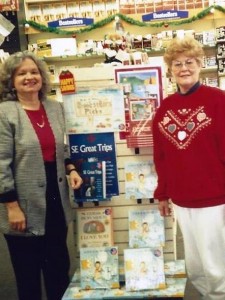 when I became “Ms Chattanooga,” a spokeperson for a beautiful city; so precious to me I wrote a guidebook about it (Chattanooga Great Places) and a second guidebook about the surrounding area (SE Great Trips). And then (it follows) a weekly travel column for the Chattanooga Times entitled “Here or There” which focused on things to experience in and around that lovely town. (Me, left, with books and illustrator Betty Harrelson, Books A Million in Chattanooga, 1996.)
when I became “Ms Chattanooga,” a spokeperson for a beautiful city; so precious to me I wrote a guidebook about it (Chattanooga Great Places) and a second guidebook about the surrounding area (SE Great Trips). And then (it follows) a weekly travel column for the Chattanooga Times entitled “Here or There” which focused on things to experience in and around that lovely town. (Me, left, with books and illustrator Betty Harrelson, Books A Million in Chattanooga, 1996.)
Those were very happy days, living in a place I loved and then pointing out to everyone how wonderful it was! That’s what we all should do, I believe. Just think, if every single person in the US of A really cared about their homeplace, and bragged about it, and worked to make it the absolute finest place in their part of the world, then – well gee! No urban blight, no rural downtrod, no crumbling infrastructures; you get the idea. So here’s my message, wherever you are. TODAY, do these three things: » read more
» posted on Sunday, January 31st, 2016 by Linda Lou Burton
 Linda Burton posting from Arkadelphia, Arkansas – A round-about skew of circumstances brought me back to grant writing a few months ago. Yes, the writing of grant proposals in order to raise money for a cause. In this particular case, a very good cause, right here in Clark County, Arkansas. How much do you know about HUNGER in America? The politically correct term is “food insecurity” which is defined as being uncertain where your next meal is coming from. Riding across the vast wheat fields of Montana and corn fields of Nebraska, it seems like a fairy tale gone bad to think enough food isn’t getting to enough people. How could that be?
Linda Burton posting from Arkadelphia, Arkansas – A round-about skew of circumstances brought me back to grant writing a few months ago. Yes, the writing of grant proposals in order to raise money for a cause. In this particular case, a very good cause, right here in Clark County, Arkansas. How much do you know about HUNGER in America? The politically correct term is “food insecurity” which is defined as being uncertain where your next meal is coming from. Riding across the vast wheat fields of Montana and corn fields of Nebraska, it seems like a fairy tale gone bad to think enough food isn’t getting to enough people. How could that be?
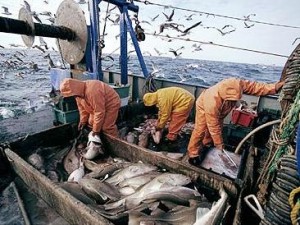 Consider the seafood along our coasts and rivers – Gulf shrimp, northwest salmon, northeast cod, and those famous Mississippi catfish. Consider the beef cattle in Texas, the pork raised in Iowa. Consider the milk and cheeses of Wisconsin, the potatoes of Idaho, the Florida oranges, the California grapes. Consider that Arkansas is the
Consider the seafood along our coasts and rivers – Gulf shrimp, northwest salmon, northeast cod, and those famous Mississippi catfish. Consider the beef cattle in Texas, the pork raised in Iowa. Consider the milk and cheeses of Wisconsin, the potatoes of Idaho, the Florida oranges, the California grapes. Consider that Arkansas is the  top rice-growing state in the country, producing nearly 9 billion pounds annually. Yet Arkansas ranks as the 2nd most food insecure state in the nation, with 19.9% of its people not having enough to eat. That is 1 out of every 5! In Arkadelphia’s Clark County, where that rate is even higher, a group of people, chins set and purposeful, decided to step up and do something about it. An idea is where everything begins, and that idea stretched out over the how’s and who’s until finally, incorporated with by-laws and a few donations in hand, the Clark County Ecumenical Food Pantry (CCEFP) was born. Exactly who are they, and what have they done since their beginnings in August 2014?
top rice-growing state in the country, producing nearly 9 billion pounds annually. Yet Arkansas ranks as the 2nd most food insecure state in the nation, with 19.9% of its people not having enough to eat. That is 1 out of every 5! In Arkadelphia’s Clark County, where that rate is even higher, a group of people, chins set and purposeful, decided to step up and do something about it. An idea is where everything begins, and that idea stretched out over the how’s and who’s until finally, incorporated with by-laws and a few donations in hand, the Clark County Ecumenical Food Pantry (CCEFP) was born. Exactly who are they, and what have they done since their beginnings in August 2014?
During its first year of operation, 456 families representing 1,022 Clark County food-insecure residents enrolled in the CCEFP program. Working with a first-year budget of $7,000, approximately 43,500 pounds of food with an estimated retail value of $101,400 were distributed to those families. How in blazes was that possible? » read more
» posted on Thursday, December 31st, 2015 by Linda Lou Burton
 Linda Burton posting from Arkadelphia, Arkansas – When is the best time to put a jigsaw puzzle together? A rainy day seemed right, when Brother was visiting during Thanksgiving week. I pulled out the State Flags and Capitols box I’d been saving for just such a day and dumped all one thousand pieces onto the card table. Brother raised an eyebrow and shook his head. I let tiny puzzle pieces filter through my fingers, trying to think of a working plan.
Linda Burton posting from Arkadelphia, Arkansas – When is the best time to put a jigsaw puzzle together? A rainy day seemed right, when Brother was visiting during Thanksgiving week. I pulled out the State Flags and Capitols box I’d been saving for just such a day and dumped all one thousand pieces onto the card table. Brother raised an eyebrow and shook his head. I let tiny puzzle pieces filter through my fingers, trying to think of a working plan.  “What strategy should I use?” I asked. “Colors,” was his reply. Now, generally speaking, that is good jigsaw strategy. But when the picture is 50 state flags, well that’s when you discover that most state flags are blue. In fact, only four state flags don’t have at least a touch of blue in them – Alabama, California, Maryland, and New Mexico.
“What strategy should I use?” I asked. “Colors,” was his reply. Now, generally speaking, that is good jigsaw strategy. But when the picture is 50 state flags, well that’s when you discover that most state flags are blue. In fact, only four state flags don’t have at least a touch of blue in them – Alabama, California, Maryland, and New Mexico.
The puzzle pieces sat in a pile for several days, as I half-heartedly tried to sort blue from blue from blue. After brother left, I raked everything back into the box and headed for my sewing basket. Being heavily dependent on Excel spreadsheets to help me organize almost everything in life, I grabbed a spool of thread and the scissors and with a little Scotch tape turned the 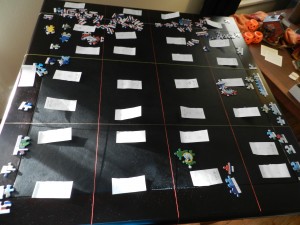 card table into Columns and Rows. Then I put Post-Its into each section marking which state fit where. Aha! I dug into those thousand pieces again looking for words. “Mon” went into the Montana section, “sas” into the Arkansas slot; I was on a roll! How many flags have outspread eagle wings? Just two – Iowa and North Dakota. Plop plop. The palm tree went to Hawaii; the horses to Pennsylvania, the bison belonged to Wyoming. The challenge began to be fun, and (with magnifying glass in hand) I began to notice the details within the flags. I didn’t expect to have a learning experience, but that is exactly what happened. In my two-year Journey to 50 states, I didn’t pay much attention to the state flags. But suddenly I realized that flags are the story-telling devices of the state. And I love a good story! » read more
card table into Columns and Rows. Then I put Post-Its into each section marking which state fit where. Aha! I dug into those thousand pieces again looking for words. “Mon” went into the Montana section, “sas” into the Arkansas slot; I was on a roll! How many flags have outspread eagle wings? Just two – Iowa and North Dakota. Plop plop. The palm tree went to Hawaii; the horses to Pennsylvania, the bison belonged to Wyoming. The challenge began to be fun, and (with magnifying glass in hand) I began to notice the details within the flags. I didn’t expect to have a learning experience, but that is exactly what happened. In my two-year Journey to 50 states, I didn’t pay much attention to the state flags. But suddenly I realized that flags are the story-telling devices of the state. And I love a good story! » read more
» posted on Monday, November 30th, 2015 by Linda Lou Burton
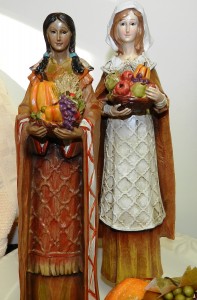 Linda Burton posting from Arkadelphia, Arkansas – I bought two figures at Hobby Lobby a few months back. One is a dark-skinned woman with plaited hair, her black braids draped over her shoulders atop a fringed shawl; the other a fair-skinned woman with slightly reddish hair, cut shoulder length, the hood of her shawl softly framing her face. Native American? Scotch-Irish? Wearing finely tanned animal skins and finely stitched linen? Both are carrying baskets filled with food – pumpkins, squash, apples, grapes. Both are beautiful, and serene. “The spirit of Thanksgiving,” I thought when I spotted them. “My heritage, and just right for the November dining table.” I added gourds from the grocery; odd-shaped greens and yellows; plus several round ones tinged with orange. Brother was coming for most of Thanksgiving week; coming to this place we’d found together by an accident of fate. Have I told you this before? The Journal? The Search? The Arkansas tragedy?
Linda Burton posting from Arkadelphia, Arkansas – I bought two figures at Hobby Lobby a few months back. One is a dark-skinned woman with plaited hair, her black braids draped over her shoulders atop a fringed shawl; the other a fair-skinned woman with slightly reddish hair, cut shoulder length, the hood of her shawl softly framing her face. Native American? Scotch-Irish? Wearing finely tanned animal skins and finely stitched linen? Both are carrying baskets filled with food – pumpkins, squash, apples, grapes. Both are beautiful, and serene. “The spirit of Thanksgiving,” I thought when I spotted them. “My heritage, and just right for the November dining table.” I added gourds from the grocery; odd-shaped greens and yellows; plus several round ones tinged with orange. Brother was coming for most of Thanksgiving week; coming to this place we’d found together by an accident of fate. Have I told you this before? The Journal? The Search? The Arkansas tragedy?
It’s a story of our country really; our own personal connection to thousands of stories of the great westward migration, stories of pioneers, of courage, and change. Ours centers on a little girl named Martha Jane, who rolled through Clark County, Arkansas in November 1849 at the tender age of four. What an adventure! » read more













